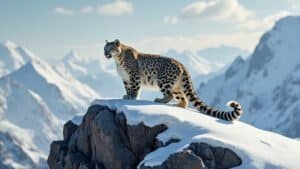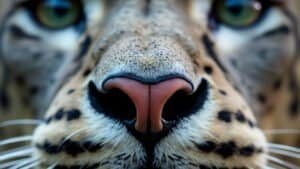Introduction
The snow leopard’s tongue is an extraordinary tool, equipped with specialized adaptations that support its survival in harsh, high-altitude environments
Its rough, barbed texture, created by backward-facing papillae, serves dual purposes: efficiently grooming its thick fur to maintain cleanliness and removing meat from bones during feeding. These features are vital for navigating its cold habitat, ensuring its coat remains insulated and its diet provides the nutrients it needs
This article delves into the unique characteristics of a snow leopard’s tongue, exploring how its structure aids in grooming, feeding, and survival in its mountainous domain
The Unique Structure of a Snow Leopard’s Tongue
The snow leopard’s tongue is a key adaptation that supports its survival in the cold, mountainous regions it inhabits. Its structure is specialized for grooming and feeding, ensuring the animal can maintain its dense coat and process prey effectively
Characteristics of Papillae and Their Rough Texture
The surface of a snow leopard’s tongue is covered with backward-facing papillae, which are small, hook-like structures made of keratin—the same protein found in human nails and hair. These papillae give the tongue its rough, sandpaper-like texture, a feature common among big cats
The papillae play a crucial role in grooming and feeding. Their hooked shape allows them to catch and remove debris, dirt, and loose fur during grooming
Reed et al. (2020) noted that the papillae’s design is optimized for detangling the snow leopard’s dense coat, ensuring its fur remains clean and effective at insulating against the cold
How the Tongue Supports Grooming Dense Fur
Snow leopards rely heavily on their thick, double-layered fur to protect them from extreme cold. The outer layer guards against wind and moisture, while the dense undercoat traps heat close to the body. Regular grooming with their rough tongue ensures the coat remains in top condition
The papillae act like tiny combs, detangling fur and removing dirt, debris, and parasites. This grooming process not only keeps the coat clean but also distributes natural oils, which enhance water resistance and insulation
Johnson (2021) highlighted that without these grooming mechanisms, snow leopards would struggle to maintain the integrity of their fur, leaving them vulnerable to the cold
Role of the Tongue in Meat Processing and Feeding
In addition to grooming, the snow leopard’s tongue is a vital tool for feeding. The papillae’s rough texture is highly effective at scraping meat from bones, ensuring the animal can maximize its caloric intake from each kill
This is particularly important in the snow leopard’s sparse, high-altitude habitat, where prey is scarce
Hanson (2019) observed that the backward-facing orientation of the papillae helps grip and tear flesh, reducing the effort required to strip meat from bones. This adaptation allows snow leopards to efficiently consume their prey, minimizing the time they spend exposed to potential threats while feeding
The dual functionality of the snow leopard’s tongue—grooming and feeding—demonstrates its importance as a survival tool
Its specialized structure not only maintains the animal’s health and appearance but also ensures it can extract the maximum nutritional value from its food, supporting its survival in a challenging environment
Adaptations for Survival in Cold, Harsh Environments
The snow leopard’s tongue is an essential adaptation for thriving in the cold, rugged terrains of Central and South Asia’s mountainous regions
Its unique structure provides advantages in grooming and feeding that directly support the snow leopard’s ability to endure extreme environmental conditions
Thermoregulatory Benefits of Grooming with the Tongue
In the frigid temperatures of the snow leopard’s habitat, maintaining the insulating properties of its fur is crucial for thermoregulation
The tongue’s rough texture, equipped with keratinized papillae, allows the snow leopard to groom its dense coat effectively, removing tangles and debris that could compromise insulation
Reed et al. (2020) noted that regular grooming ensures that the undercoat remains fluffy and traps warm air close to the skin. By distributing natural oils through the fur, grooming also enhances water resistance, which is critical for staying warm and dry in snow-covered environments
Without these grooming behaviors, the snow leopard’s fur would lose its insulating efficiency, increasing its risk of hypothermia
Differences Between Snow Leopard Tongues and Other Big Cats
While all big cats have tongues with rough, papilla-covered surfaces, the snow leopard’s tongue is uniquely adapted to its environment
The papillae on a snow leopard’s tongue are slightly longer and more curved than those of lions or tigers, enhancing their effectiveness at detangling dense fur and scraping meat from bones
Johnson (2021) highlighted that these differences reflect the snow leopard’s reliance on its tongue for survival in an environment where maintaining a pristine coat and extracting every possible nutrient from prey are paramount
In contrast, big cats in warmer climates may use their tongues more for feeding and less for intensive grooming, as their fur does not serve the same insulating purpose
Evolutionary Advantages of the Tongue’s Design
The snow leopard’s tongue represents an evolutionary advantage that contributes to its success in a harsh, high-altitude environment. The keratinized papillae not only aid in grooming and feeding but also allow the snow leopard to conserve energy and maintain optimal health
Spencer (2022) emphasized that the dual functionality of the tongue reduces the snow leopard’s need to rely on external resources or tools for survival. By efficiently grooming its fur and consuming its prey, the snow leopard minimizes the risks associated with exposure to the cold or prolonged feeding periods
These adaptations ensure that the snow leopard can sustain itself even in one of the most challenging habitats on Earth, underscoring the importance of its tongue as a multifunctional survival tool
Insights from Research on Snow Leopard Tongues
Scientific studies of snow leopard tongues have provided valuable insights into how their unique structure supports grooming, feeding, and overall survival
These findings highlight the specialized anatomy and biomechanics of the snow leopard’s tongue and its critical role in maintaining health and efficiency in a challenging environment
Studies on Papillae Functionality and Feeding Behavior
Research into the papillae on the snow leopard’s tongue has revealed their importance in maximizing feeding efficiency
The backward-facing keratinized structures act like miniature scrapers, allowing the snow leopard to remove meat from bones with minimal effort. This capability is essential for survival in high-altitude regions where prey is scarce and every meal must be fully utilized
Hanson (2019) conducted a comparative study on the feeding behaviors of carnivores, noting that the snow leopard’s papillae are particularly well-suited for processing large prey
The study found that these papillae increase the tongue’s surface area, enhancing its ability to grip and tear flesh. This efficiency allows snow leopards to spend less time feeding and reduces their exposure to potential threats
The Role of Tongue Anatomy in Prey Consumption Efficiency
Biomechanical analyses of snow leopard tongues have shown how their structure supports the animal’s energy conservation during feeding. The rough texture not only aids in scraping meat but also helps remove fur and feathers from prey, ensuring that only edible portions are consumed
Reed et al. (2020) observed that the papillae work in conjunction with the snow leopard’s teeth and jaw muscles, creating a highly efficient system for breaking down food
This synergy minimizes energy expenditure during feeding, which is critical for snow leopards living in environments where energy resources are limited
How the Tongue Aids in Maintaining Coat Health
The grooming capabilities of the snow leopard’s tongue are equally important for its survival. By detangling fur and removing debris, the tongue helps maintain the insulating properties of the snow leopard’s thick coat
This grooming process also prevents the buildup of parasites and dirt, which could compromise the animal’s health
Johnson (2021) emphasized that regular grooming not only keeps the fur clean but also promotes the even distribution of natural oils. These oils enhance the coat’s ability to repel water and maintain insulation, ensuring that the snow leopard stays warm and dry in snow-covered conditions
Research into the snow leopard’s tongue has deepened our understanding of its multifaceted role in grooming and feeding. These findings underscore the importance of this specialized structure in supporting the snow leopard’s survival in one of the world’s most extreme environments
Conclusion
The snow leopard’s tongue is a remarkable adaptation that plays a crucial role in its survival within the harsh, high-altitude environments it inhabits
Its rough, papilla-covered surface is perfectly designed for grooming the dense, double-layered fur that provides essential insulation against extreme cold. At the same time, the tongue aids in feeding by efficiently removing meat from bones, ensuring the snow leopard maximizes its caloric intake in regions where prey is scarce
Scientific studies have highlighted the dual functionality of the snow leopard’s tongue, emphasizing its importance in both maintaining coat health and enhancing feeding efficiency. These insights underscore the tongue’s role as a multifunctional tool, reflecting the evolutionary ingenuity of this elusive predator
By combining effective grooming and feeding capabilities, the snow leopard’s tongue helps it thrive in some of the world’s most challenging habitats, showcasing nature’s ability to adapt and specialize for survival













